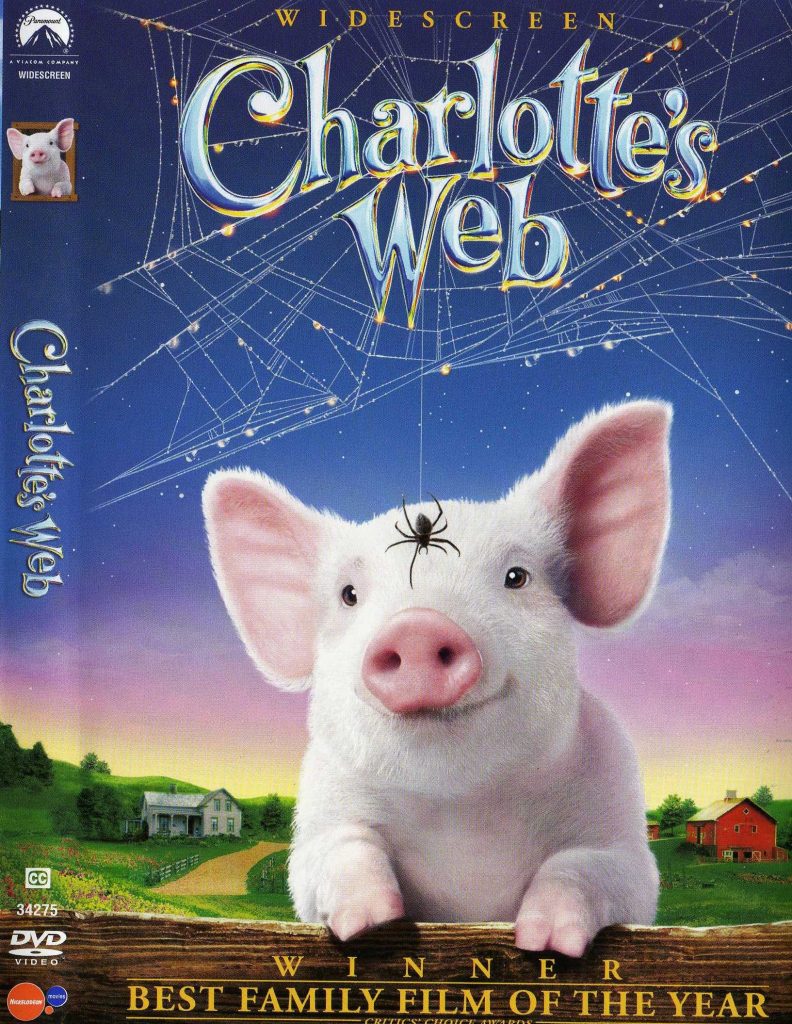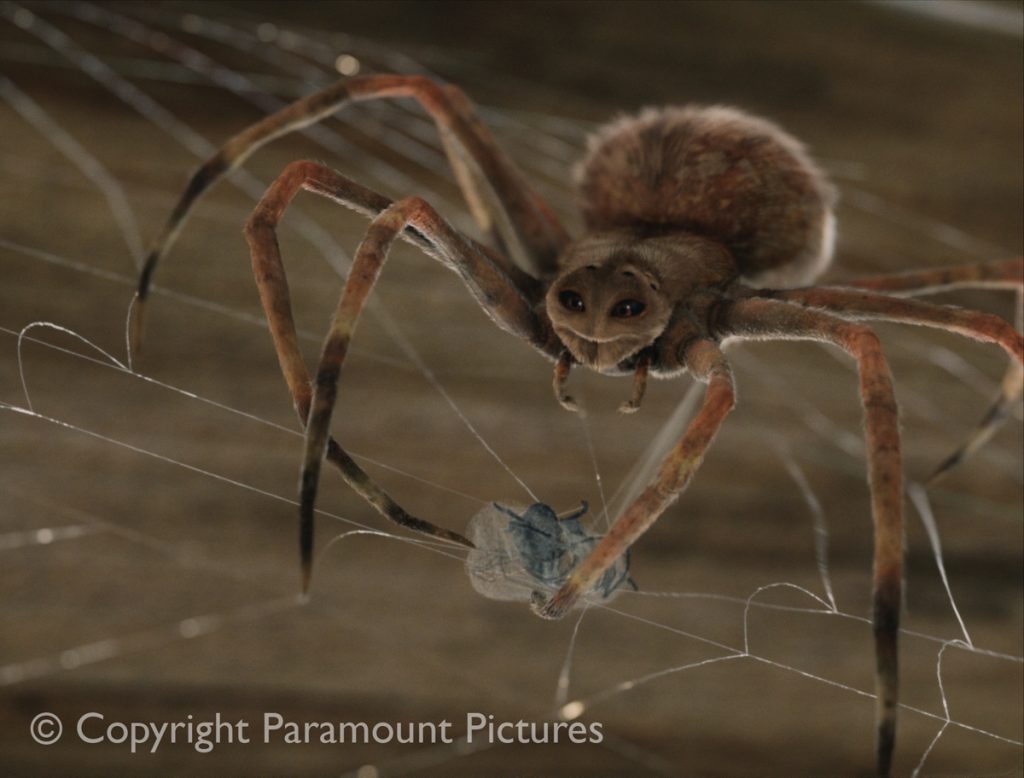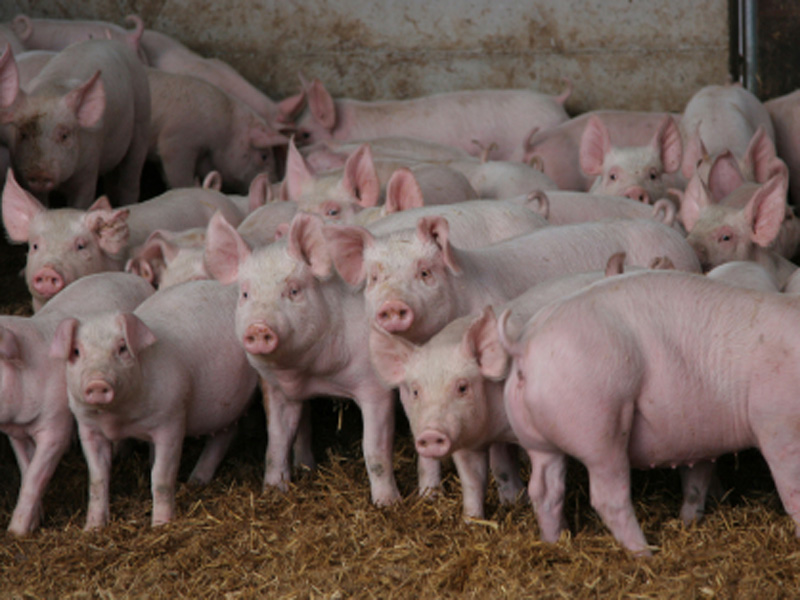Based on the classic children’s story by E. B. White, Charlotte’s Web (2006) follows the journey of a runty piglet, Wilbur (Dominic Scott Kay), saved by the farmer’s daughter Fern (Dakota Fanning) and raised on the nearby farm. Wilbur remains friendless until he meets Charlotte (Julia Roberts), the spider who lives in the barn. Although initially repulsed by her, her kindness and his open-minded nature results in them forming a friendship of incredible selflessness and loyalty. As the likelihood that he will be killed by Christmas looms, we grow to trust in Charlotte’s promise to protect him. She writes words describing Wilbur in her web, gaining the support of the other animals and attracting widespread human interest. As Angie Errigo suggests, ‘[Charlotte’s] qualities and [Wilbur’s] admiration for her show the barn’s other arachnophobic residents that every being is special and has a purpose.’[1] We too are touched by Charlotte, who against all odds proves that love can come from anywhere.
Charlotte’s Web is ‘a well-crafted family film that appeals to all ages’[2]; its simple plot allows for deeper analysis and self-reflection whilst the presence of animals distances the audience (particularly children) from harsh criticism of the actions of humans through an allegorical representation of human values demonstrated by the animals. Jordan Kerner, the film’s producer, explains how “This was an extremely complex movie because we combine live action, animatronics, children, stunts, and CG animation”[3]. Gary Winick took a large risk not only in choosing the live-action format, full of live animals, but also to create Charlotte and Templeton, the two most ‘creepy, scary, repulsive, and gross’[4] characters, with photoreal CGI. Admittedly, aspects of their appearance were adapted to make them slightly more visually pleasing but ultimately they are both extraordinarily realistic. The result is that even children are expected to challenge their initial response to Charlotte and Templeton, echoing Wilbur’s character arc, in learning that all creatures (humans included) deserve to be treated with love and respect.

Charlotte’s Web Poster- ‘Best Family Film of the Year’
The creation of Charlotte is a fascinating example of how anthropomorphising animals helps us to connect with them emotionally. Certain features of Charlotte were stylized: ‘the designers gave her face a subtle heart shape, and they made all eight of her eyes almond-shaped to suggest femininity. In addition, above each of the two main eyes, they placed a pair of secondary eyes representing eyebrows, to help her emote.’[5]The film succeeds in finding a balance between realism and animation, whilst also making Charlotte a likeable character. Of course it is not only her appearance which leads us to like her, in fact I would argue the opposite; in her first scene we hear her talking off-camera; Charlotte comes across as kind, gentle and intelligent before we even see her. As Audrey Doyle notes, ‘Although Charlotte is a spider, she talks and conveys emotions like a human would’[6], enabling her to become more endearing. Of course, we can credit Julia Roberts’ portrayal of her character to a large extent for this!

Charlotte with fly on her web (Instinctively gross but stylized slightly to be made more attractive)
Even in giving herself a name she asserts her individuality, standing out from any ordinary, nameless spider. Notably, the intellectuality of Charlotte enhances her likeability. Even her greeting, ‘Salutations’[7], distinguishes her from the more basic ‘Hello’. She is not only literate, but seemingly ‘well-educated’ knowing words the other farm animals don’t, least of all Wilbur (fortunately Wilbur is cute!). Charlotte also embodies values associated with humans: compassion, selflessness, love and community. She is loyal to her promise to Wilbur, valuing her integrity above all things, and in turn we respect her. Importantly, these aspects of Charlotte’s character which prompt our empathy depend on her anthropormorphism. The more human-like she is (in character and appearance), the more we trust her. As a result it raises into question our ability as humans to feel compassion for non-humans as they are, rather than how like us they are.
Wilbur is also anthropomorphised: he is able to talk to the other animals in the barn, he can smile and back-flip, he misses Fern and feels lonely without his friends. There is extensive evidence to suggest that pigs are very smart, sentient beings.[8] Bob Comis, a pig-turned-vegetable farmer, wrote to The Dodo to explain his reasons behind the change of livelihood in not only giving up eating meat, but giving up on farming pigs too. He explains that ‘it is morally wrong to kill animals for food, especially highly sentient, emotionally rich animals with great capacity for suffering and strong, clearly expressed interests.’ Although Bob Comis is not a pig-farming prophet by any means, his U-turn is based on his confident beliefs, embodied by Wilbur, that animals can feel fear and pain. The film then is perhaps suggesting that the meat industry is cruel. But does it go far enough in these assertions? At the end of Charlotte’s Web Wilbur is not killed for Christmas dinner, however we do see the family happily tuck into other meat. Perhaps the film prioritises Wilbur because he is the runt of the litter, the underdog.

We can see a similar ambivalence in E.B. White’s essay Death of a Pig which describes how he felt when one of his pigs died prematurely after three to four days of him caring for it. He notes, ‘The loss we felt was not the loss of ham but the loss of pig. He had evidently become precious to me’, and therefore this pig, an underdog like Wilbur, is given sympathy not expected from a pig farmer. He also describes the rearing and killing of the pigs as ‘murder’ and a ‘tragedy’. The correlation between this story and his children’s book Charlotte’s Web, to which the film is faithful, cannot be understated. The difficulty that White struggles to accommodate his profession and his connection with one such pig is reconciled in his personal connection to the pig, on a greater level than is normally the case. After attempted to nurse the pig to health he suggests ‘The pig’s lot and mine were inextricably bound now’.Similarly, with Wilbur, we see him as an individual as opposed to a concept and the film’s final focus is actually on Charlotte, viewed from Wilbur’s perspective, encouraging us to look beyond our prejudices. The use of animals in the film is crucial to the allegory. To expose children to the harsh realities of life and their own human prejudices would not only be inappropriate and unsuccessful in many ways (all prejudices are different and so there’d be a lack of universality, crucial to the family film), but also pretty unpleasant. By distancing children from the moral just enough that they can appreciate it without feeling too personally criticised, the film is able to have a greater impact within the family film genre.
Nevertheless, if any attempts are made to break down the human-animal barrier by the end of the film it’s firmly in place: Wilbur and the other animals sit in the barn whilst the humans feast on unknown, nameless animals. Fern argues at the beginning that killing Wilbur is ‘unfair and unjust’[9], stating it would be ‘no different’[10] if she were killed in a similar manner. However, the film shows her moving on from Wilbur, as she grows up and becomes a ‘woman’, and sees the bigger picture. The allegory is established by Charlotte and Wilbur, illustrating the importance of friendship, even for those who society reject – you never know, it might just save your life! This moral is fitting for a family film; it is universal, and integral to being a good person.
Dakota Fanning interview showing Fern’s character arc: see 4.12-4.52
This bitter-sweet ending is rescued by the memory of Charlotte, who stuck to her promise, whose loyalty was unfailing, and who lives on in her three children who chose to stay at the barn. Just as their birth signifies hope, her death is necessary in solidifying our empathy for her and forcing us to re-evaluate our judgements. We might choose to read the film’s vague summary to be celebrating Wilbur, but as with any good family film there is a depth to be explored:
“An ordinary pig, a runt no less, stood surrounded by friends welcoming his second spring. […] All because somebody stopped to see the grace and beauty and nobility of the humblest creature. That is the miracle of friendship.”[11]
I believe it is purposefully unclear, ‘somebody’ could mean anybody, as could ‘creature’. The use of the word ‘humble’ refers to Charlotte’s description of Wilbur, however I feel it applies just as accurately to Charlotte. That she was graceful, beautiful and noble in undeniable. Here the film allows us to become the ‘somebody’ and to recognise our own journey in learning to appreciate Charlotte.
Charlotte’s Web faces the usual challenges which arise from attributing human characteristics to animals in an attempt to allow us to relate to them, and consequently learn something from our reaction to them. It raises our expectations on how the world should respond to these animals, and fails to accommodate fully for this. That spiders are not evil creatures out to kill us all I can (partly) accept, but that pigs should be kept as pets is something society finds more difficult to comprehend.
In this visually realistic film it is tempting to believe in a parallel world where animals could talk, and ignore the underlying symbolism. But Winick’s representation of core human values embodied allows us to instead relate to the film’s ideas on friendship, love, loyalty and loss instead of the characters themselves. Fern’s character symbolises the film’s ultimate detachment from the human-animal relationship. As she grows up and accepts that keeping a pet pig is not what happens in the real world, the film allows us to relate to the other, more important relationship, presented; Charlotte and Wilbur. Accordingly, the animal-human boundary is partially broken down in order to cement it further. The overarching focus on Charlotte and Wilbur’s relationship serves to emphasise a theme present in the film, perhaps more so than in the original book, and Winick’s decision to portray Charlotte as an outsider, ostracised by the rest of the barn, instead of the loved and respected motherly figure that E. B. White created, highlights the strength of their friendship and the kindness of Wilbur. Edie Erickson suggests that ‘While birth and death are part of the storyline of the movie, the theme seems to focus more upon ordinary creatures doing extraordinary things’ adding that ‘Birth and death are not necessarily topics that many children can relate with. The idea of being ordinary, however, is much more relatable.’ Therefore, ‘Through Charlotte’s beautiful webs and Wilbur’s innocence, the creatures [in the barn] are transformed’ and the viewer realises that even the most ordinary of creatures can be extraordinary. As one reviewer notes, ‘It’s more than a movie about Some Pig, it’s a story about exalting in life, celebrating change, and finding hope in death.’[12]
Parallels can be drawn between Charlotte’s Web and Chris Noonan’s Babe (1995). Set on a farm, based around a runt pig and filmed using live animals they compliment each other. Babe even presents similar hypocrisy prioritising one animal individual above another; Babe is saved from the human’s dinner plate but another animal is not so lucky. Errigo argues that ‘the barnyard antics and inter-species dynamic among sheep, cows, poultry and the adorable, innocent pink piggy struggle to escape the shadow of the peerless Babe,’[13] however I would disagree. Babe’s fundamental argument rests on the irreconcilable relationship between Hoggett and Babe, whilst the allegory of Charlotte and Wilbur is felicitous. In Babe we sympathise with the pig but relate to the farmer, the human, something which ultimately undermines the message of the film due to unrealised expectations on human-animal relations. Whereas in Charlotte’s Web, we follow Wilbur’s journey as our own, realising the power of friendship and treating those around us with the kindness we’d like to be treated with. For that reason, Charlotte’s Web is the perfect family film, conveying an extraordinary message.
Bibliography
● Abell, Sophie, ‘Charlotte’s Web (U)’, London Net (2006) http://www.londonnet.co.uk/films/charlottesweb.html [Accessed 22/11/2015]
● Charlotte’s Web. Dir. Gary Winick. Paramount Pictures, 2006
● Comis, Bob, ‘Here’s my plan to quite pig farming and start living ethically’, The Dodo (2014) <https://www.thedodo.com/my-plan-to-quit-pig-farming-an-490419846.html> [Accessed 23/01/2016]
● Doyle, Audrey, ‘Web Design : A Realistic CG Charlotte and Templeton Act Alongside A Real Barnyard Cast In The Latest Iteration of Charlotte’s Web’, Computer Graphics World, Volume: 29 Issue: 12 (2006) <http://www.cgw.com/Publications/CGW/2006/Volume-29-Issue-12-Dec-2006-/Web-Design.aspx> [Accessed 22/11/2015]
● Erickson, Edie, ‘TE 838 – Charlotte’s Web – Film/Book Comparisons’, Edie Erickson Educator’s Portfolio (2014) <http://upteach.weebly.com/maet-blog/te-838-filmbook-comparisons> [Accessed 23/01/2016]
● Errigo, Angie, ‘Charlotte’s Web’, Empire (2007) http://www.empireonline.com/movies/charlotte-web/review/ [Accessed 22/11/2015]
● Kerner, Jordan, ‘Charlotte’s Web : Filming in Radiant Victoria, Australia’, Cinema Review (2006) http://www.cinemareview.com/production.asp?prodid=3790 [Accessed 22/11/2015]
● Tyler, Josh, ‘Movie Review: Charlotte’s Web’, Cinemablend http://www.cinemablend.com/reviews/Charlotte-s-Web-1945.html [Accessed 22/11/2015]
● White, E. B., ‘Death of a Pig’, The Atlantic (January 1948) <http://www.theatlantic.com/magazine/archive/1948/01/death-pig/309203/> [Accessed 23/01/2016]
● White, E. B., Charlotte’s Web, (United States: Harper & Brothers, 1952)
Further Reading/Watching:
Chuck the Movieguy, ‘Charlotte’s Web Dakota Fanning Interview’, Youtube (2006) https://www.youtube.com/watch?v=P3PHVqn2Gvg [Accessed 22/11/2015]
Goodnews Don and Cheryl, ‘Goodnews TV & Charlotte’s Web’, Youtube (2008) https://www.youtube.com/watch?v=9mNF35DIsDg&list=PL211423D195AE1003 [Accessed 22/11/2015]
Peszko, J. Paul, ‘Spinning a New Charlotte’s Web’, Animation World Network (2006) http://www.awn.com/vfxworld/spinning-new-charlotte-s-web [Accessed 22/11/2015]
Roxanna Bina, ‘Dakota Fanning for Charlotte’s Web’, Youtube (2008) https://www.youtube.com/watch?v=WYEynkFKaIE [Accessed 22/11/2015]
[1] Angie Errigo, ‘Charlotte’s Web’, Empire (2007) http://www.empireonline.com/movies/charlotte-web/review/ [Accessed 22/11/2015] (para. 2)
[2] Sophie Abell, ‘Charlotte’s Web (U)’, London Net (2006) http://www.londonnet.co.uk/films/charlottesweb.html [Accessed 22/11/2015] (para. 2)
[3] Jordan Kerner, ‘Charlotte’s Web : Filming in Radiant Victoria, Australia’, Cinema Review (2006) http://www.cinemareview.com/production.asp?prodid=3790 [Accessed 22/11/2015] (para. 1)
[4] Audrey Doyle, ‘Web Design : A Realistic CG Charlotte and Templeton Act Alongside A Real Barnyard Cast In The Latest Iteration of Charlotte’s Web’, Computer Graphics World, Volume: 29 Issue: 12 (2006) <http://www.cgw.com/Publications/CGW/2006/Volume-29-Issue-12-Dec-2006-/Web-Design.aspx> [Accessed 22/11/2015] (para. 1)
[5] ibid., (para. 11)
[6] ibid., (para. 18)
[7] Charlotte’s Web. Dir. Gary Winick. Paramount Pictures, 2006
[8] David Pearce, ‘The Antispeciest Revolution’, Institute for Ethics and Emerging Technologies (2013) http://ieet.org/index.php/IEET/more/pearce20130726 [Accessed 24/11/2015] (para. 5)
AND
Grace Clement, ‘ “Pets or Meat?” Ethics and Domestic Animals’, Journal of Animals Ethics, Volume: 1, No.1 (2011) http://www.jstor.org/stable/10.5406/janimalethics.1.1.0046 [Accessed 24/11/2015] p.46
[9] Charlotte’s Web. Dir. Gary Winick. Paramount Pictures, 2006
[10] Charlotte’s Web. Dir. Gary Winick. Paramount Pictures, 2006
[11] Charlotte’s Web. Dir. Gary Winick. Paramount Pictures, 2006
[12] Josh Tyler, ‘Movie Review: Charlotte’s Web’, Cinemablend http://www.cinemablend.com/reviews/Charlotte-s-Web-1945.html [Accessed 22/11/2015] (para. 2)
[13] Angie Errigo, ‘Charlotte’s Web’, Empire (2007) http://www.empireonline.com/movies/charlotte-web/review/ [Accessed 22/11/2015] (para. 1)